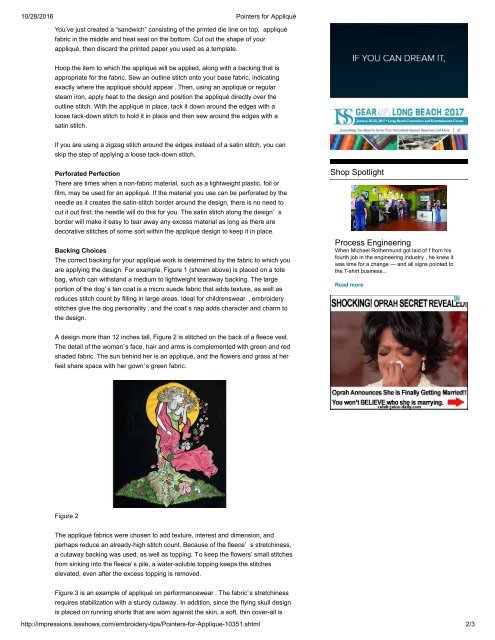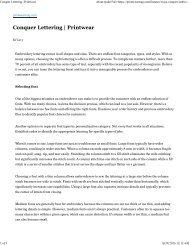Embroidery Basics Articles
You also want an ePaper? Increase the reach of your titles
YUMPU automatically turns print PDFs into web optimized ePapers that Google loves.
10/28/2016 Pointers for Appliqué<br />
You’ve just created a “sandwich” consisting of the printed die line on top, appliqué<br />
fabric in the middle and heat seal on the bottom. Cut out the shape of your<br />
appliqué, then discard the printed paper you used as a template.<br />
Hoop the item to which the appliqué will be applied, along with a backing that is<br />
appropriate for the fabric. Sew an outline stitch onto your base fabric, indicating<br />
exactly where the appliqué should appear . Then, using an appliqué or regular<br />
steam iron, apply heat to the design and position the appliqué directly over the<br />
outline stitch. With the appliqué in place, tack it down around the edges with a<br />
loose tackdown stitch to hold it in place and then sew around the edges with a<br />
satin stitch.<br />
If you are using a zigzag stitch around the edges instead of a satin stitch, you can<br />
skip the step of applying a loose tackdown stitch.<br />
Perforated Perfection<br />
There are times when a nonfabric material, such as a lightweight plastic, foil or<br />
film, may be used for an appliqué. If the material you use can be perforated by the<br />
needle as it creates the satinstitch border around the design, there is no need to<br />
cut it out first; the needle will do this for you. The satin stitch along the design’ s<br />
border will make it easy to tear away any excess material as long as there are<br />
decorative stitches of some sort within the appliqué design to keep it in place.<br />
Backing Choices<br />
The correct backing for your appliqué work is determined by the fabric to which you<br />
are applying the design. For example, Figure 1 (shown above) is placed on a tote<br />
bag, which can withstand a medium to lightweight tearaway backing. The large<br />
portion of the dog’ s tan coat is a micro suede fabric that adds texture, as well as<br />
reduces stitch count by filling in large areas. Ideal for childrenswear , embroidery<br />
stitches give the dog personality , and the coat’ s nap adds character and charm to<br />
the design.<br />
Shop Spotlight<br />
Process Engineering<br />
When Michael Rothermund got laid of f from his<br />
fourth job in the engineering industry , he knew it<br />
was time for a change — and all signs pointed to<br />
the Tshirt business...<br />
Read more<br />
A design more than 12 inches tall, Figure 2 is stitched on the back of a fleece vest.<br />
The detail of the woman’s face, hair and arms is complemented with green and red<br />
shaded fabric. The sun behind her is an appliqué, and the flowers and grass at her<br />
feet share space with her gown’ s green fabric.<br />
Figure 2<br />
The appliqué fabrics were chosen to add texture, interest and dimension, and<br />
perhaps reduce an alreadyhigh stitch count. Because of the fleece’ s stretchiness,<br />
a cutaway backing was used, as well as topping. To keep the flowers’ small stitches<br />
from sinking into the fleece’ s pile, a watersoluble topping keeps the stitches<br />
elevated, even after the excess topping is removed.<br />
Figure 3 is an example of appliqué on performancewear . The fabric’s stretchiness<br />
requires stabilization with a sturdy cutaway. In addition, since the flying skull design<br />
is placed on running shorts that are worn against the skin, a soft, thin coverall is<br />
http://impressions.issshows.com/embroiderytips/PointersforApplique10351.shtml 2/3




